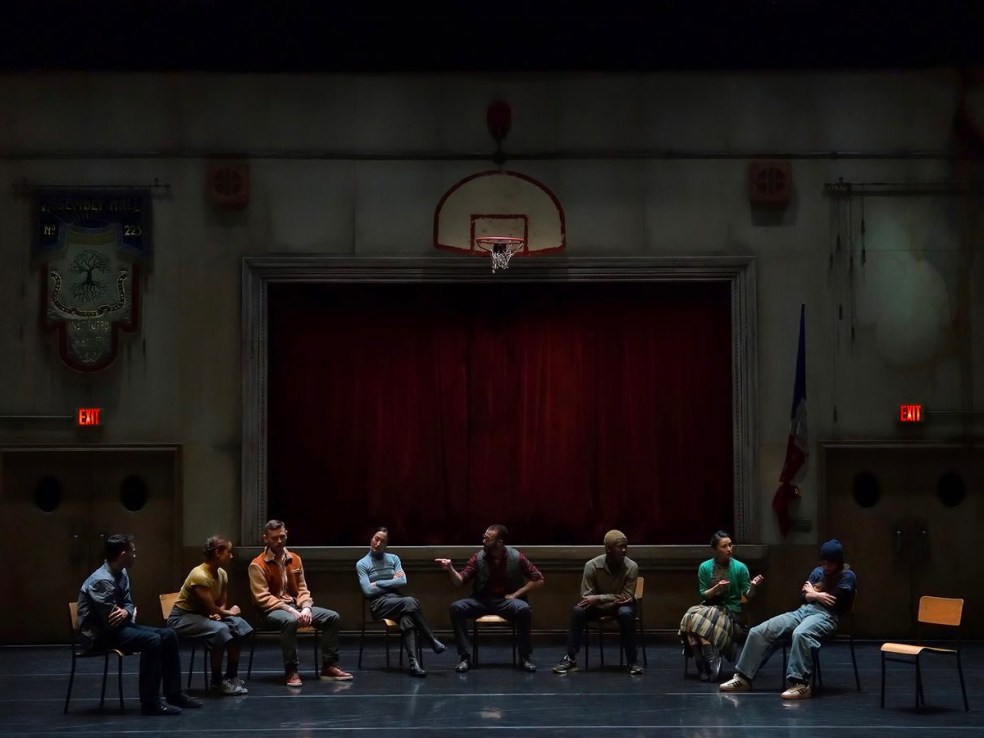Assembly Hall at Sadler’s Wells review: Enjoyment over intellect
What exactly is Assembly Hall trying to do? Can dance and theatre together express something more than words or movement on their own?


Assembly Hall | Sadler’s Wells | ★★★☆☆
Take eight dancers, nine chairs, mediaeval banqueting silverware, tin swords and weapons, a billowing flag wrapped around an enormous flagpole and place them in an empty community hall containing a stage framed like a gigantic wall painting hidden behind thick, red velvet curtains. Declare the annual general meeting of a society of medievalists open and watch as the dancers argue the way committee members playing out their true calling of re-enactors would: pretend-fighting in mediaeval style both across the floor of the titular hall, and inside the painting-framed stage.
Who are these performers and what exactly is Assembly Hall trying to do? Can cross-pollination of dance and theatre express something more than words or movement can on their own?
The performers are Kidd Pivot, a twenty-two year old Canadian dance company founded in Vancouver by choreographer Crystal Pite, who still directs and produces work for them, as well as for the Royal Ballet, Scottish Ballet, Nederlands Dans Theater and National Ballet of Canada. The text is by Jonathon Young, a playwright who collaborated with Pite on four productions, and picked up two Olivier Awards on the strength of that collaboration, for Betroffenheit (2015) and for Revisor (2019).
There is no deep and hidden meaning in Assembly Hall. On the contrary, it feels like a naughty break from universal issues and existential questions.
It’s futile to expect finely dissected psychology of characters, as the plot meanders between committee exchanges at the AGM and an ancient story being re-enacted, with no real resolution or linearity. Any spoken dialogue is deceptively narrative: words and sounds are part of the spectacle, but any reliance on these for guidance and direction for longer than a few vignettes will leave you disoriented.
It’s hard to appreciate the quality of voice work, as the spoken word is severed from the performers on stage, whose craft consists not in acting but in miming the acting that accompanies a prerecorded dialogue, through exaggerated poses and moves. Voice actors, in fact, get their own credits, separate from those of the performers.
Neither is there much runway for any dancing technique to shine, as most of what takes place, both on stage and on the stage within, can only be described as performers striking one pose after another. The occasional dance sequence makes an appearance in inverted commas, as it were.
It would seem that Assembly Hall is asking audiences to enjoy pure staging and its anarchic potential: the craft of arranging objects, sets, voices, costumes, music, gestures, light and movement in a way that delights the senses, confounds reason and that only the space-time continuum of theatre allows. There is a grandiose, painterly quality to each one of the dramatic compositions, reminiscent of Velasquez and Old Masters arranging armoured bodies in fighting pose and piercing through them with Caravaggio-style shafts of light. And then there is irreverent over-dramatising of the AGM exchanges, where Chair, Treasurer and Secretary plot, scheme and procrastinate a decision to dissolve the society of re-enactors on budgetary grounds.
To borrow an insight from Antonin Artaud, the point of Assembly Hall is purely to enjoy the metaphysics of theatre: the artistic discipline through which theatre produces its own reality and speaks its own language, one that no other art can replicate and that owes no-one any justification.



